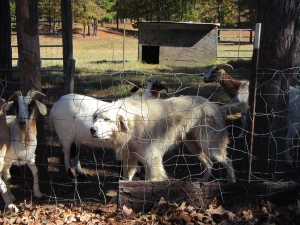
Controlling predators on a farm or ranch is not easy, Dr. David Fernandez, Extension livestock specialist and interim dean of graduate studies and continuing education for the University of Arkansas at Pine Bluff, said.
“Remember that all organisms need three keys for survival – food, shelter and water,” he said. “Eliminate any one of these, and the organism will leave or perish. Water is not possible to eliminate since your animals need water too. You can attempt to disrupt predator denning locations, but that may violate state or federal wildlife laws.”
Dr. Fernandez advises denying predators access to food, namely your livestock. Good fences are key in keeping livestock safe. Electric fencing is especially useful against dogs, coyotes and hogs. Place a hot wire about 6 inches off the ground around the perimeter. You may have to add an offset hot wire at the top of the fence to keep coyotes and dogs from jumping over. Additional electric wires may be needed to prevent predators from slipping through the fence. Four-inch square wire can prevent predators from entering property.
“Trapping, shooting, poisoning and harassment are common methods of controlling predators,” Dr. Fernandez said. “But all of these methods are coming under increasing public scrutiny and regulation as public sentiment about animals evolves beyond pets and begins to encompass wildlife. Be careful to closely follow state and federal laws when using one of these methods.”
Serious consequences can result from killing protected species or out-of-season game animals. For example, crows, which can injure or maim young livestock, are considered migratory game birds and are protected under state and federal game laws.
Guardian animals help deter predators. Equids, such as donkeys and mules, can be effective against dogs and coyotes. Only use equids individually since they will often herd together with other equids leaving the sheep and goats to fend for themselves, Dr. Fernandez said.
Llamas have been used to deter canine predators. Some llamas will attack canine predators. However, llamas primarily serve to discourage the predators from approaching since they are too large to attack.
Livestock guardian dogs have a long history of successful use. Use guardian dogs in pairs at the very least so they can protect each other in a fight, or so one can remain with the livestock while the other intercepts the predator. Three or more dogs are better, since one will stay with the livestock while the other two attack the predators.
For more information on identifying predator damage, contact Dr. Fernandez at fernandezd@uapb.edu or (870) 575-8316.
The University of Arkansas at Pine Bluff offers all its Extension and Research programs and services without regard to race, color, sex, gender identity, sexual orientation, national origin, religion, age, disability, marital or veteran status, genetic information, or any other legally protected status, and is an Affirmative Action/Equal Opportunity Employer.


